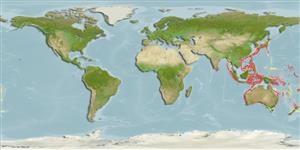Common names from other countries
Environment: milieu / climate zone / depth range / distribution range
Ekologi
marina djupbottenlevande; djupintervall 200 - 350 m (Ref. 559). Deep-water
Western Pacific: Japan to off Australia, including the Arafura Sea (Ref. 9819).
Size / Vikt / Age
Maturity: Lm ? range ? - ? cm
Max length : 70.0 cm SL hane/ej könsbestämd; (Ref. 559); common length : 35.0 cm TL hane/ej könsbestämd; (Ref. 9137)
Mjukstrålar i ryggfenan (totalt) : 94. Rather elongate body with blunt head; eye almost as long as snout; upper jaws ends well behind eye; 3 sharp spines on preopercle and 1strong opercular spine; 1 median and a pair of basibranchial tooth patches; 5-6 developed rakers on anterior gill arch; pelvic fins inserted beneath eye; precaudal vertebrae 13 (Ref. 34024). Snout spine present (Ref. 34024).
Found on the shelf and shelf edge (Ref. 11230). Common species (Ref. 34024). Oviparous, with oval pelagic eggs floating in a gelatinous mass (Ref. 205).
Life cycle and mating behavior
Maturities | Reproduktion | Spawnings | Egg(s) | Fecundities | Larver
Nielsen, J.G., D.M. Cohen, D.F. Markle and C.R. Robins, 1999. Ophidiiform fishes of the world (Order Ophidiiformes). An annotated and illustrated catalogue of pearlfishes, cusk-eels, brotulas and other ophidiiform fishes known to date. FAO Fish. Synop. 125(18):178p. Rome: FAO. (Ref. 34024)
IUCN Red List Status (Ref. 130435)
CITES (Ref. 128078)
Not Evaluated
Threat to humans
Harmless
Human uses
Fiskeri: kommersiell; sportfisk: ja
Verktyg
Special reports
Download XML
Internet-källor
Estimates based on models
Preferred temperature (Ref.
115969): 11.1 - 18.9, mean 13.4 (based on 79 cells).
Phylogenetic diversity index (Ref.
82804): PD
50 = 0.6250 [Uniqueness, from 0.5 = low to 2.0 = high].
Bayesian length-weight: a=0.00380 (0.00217 - 0.00665), b=3.14 (2.98 - 3.30), in cm Total Length, based on LWR estimates for this species & (Sub)family-body (Ref.
93245).
Trofisk nivå (Ref.
69278): 4.0 ±0.66 se; based on food items.
Resiliens (Ref.
120179): Mellan, lägsta populationsfördubblingstid 1,4-4,4 år (Preliminary K or Fecundity.).
Fishing Vulnerability (Ref.
59153): Moderate to high vulnerability (54 of 100).
